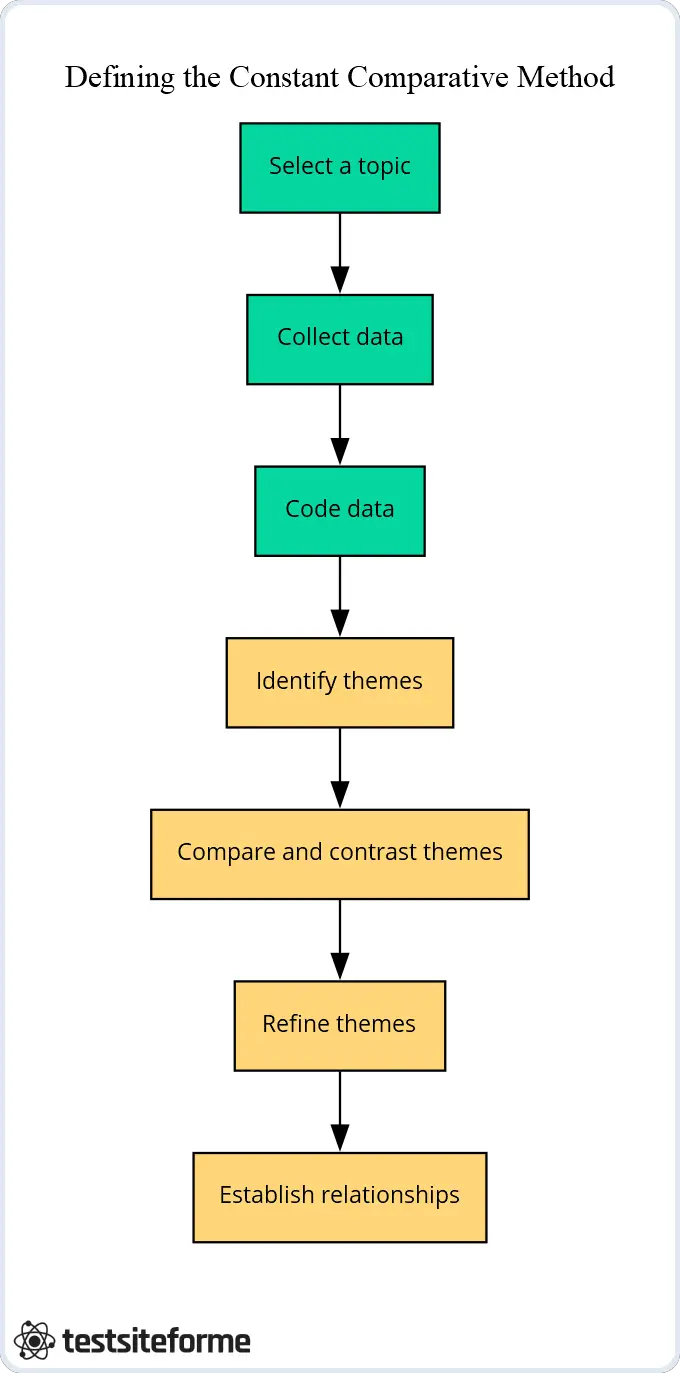Imagine you’re a social science researcher, and you’ve just collected a vast amount of qualitative data. You feel like you’re drowning in information and have no idea where to start analyzing it. The solution? Enter the Constant Comparative Method.
The Constant Comparative Method is like a lifeboat for researchers who work with qualitative data. It helps them navigate the choppy waters of analysis by providing structure and organization to their research process. In this article, we’ll explain what the Constant Comparative Method is, how it’s used in grounded theory, its benefits and limitations, tips for success, common pitfalls to avoid while using it, real-world examples of its application in research projects, alternatives to consider if it’s not quite right for your project – everything you need to know about this method!
We’ll start by defining what the Constant Comparative Method is and then provide an overview of grounded theory since that’s where this method originated. From there, we’ll dive into how the method works step-by-step so that even novice researchers can follow along easily.
Along the way, we’ll explore some real-world examples of how researchers have successfully used this method to analyze their data. We won’t shy away from discussing its limitations either – after all, no research method is perfect!
By reading through this article carefully and paying attention to our tips for success (and pitfalls), you’ll be well-equipped to decide whether or not the Constant Comparative Method is right for your next project.
Defining the Constant Comparative Method
The Constant Comparative Method is a qualitative research method used to analyze data through constant comparison. This method involves comparing new data with previously collected data, looking for similarities and differences, and developing substantive theories based on the findings. The method was first introduced by Glaser and Strauss in 1967 while studying patients’ experiences of dying in hospitals.
The Constant Comparative Method is part of a broader research approach called grounded theory, which aims to develop theoretical explanations based on empirical evidence. Grounded theory is rooted in symbolic interactionism – the idea that people’s actions are influenced by their social interactions and meanings attached to those interactions.
To use this method appropriately, researchers must follow specific procedures such as axial coding, which involves breaking down raw data into smaller segments or codes that can be analyzed more easily. These codes are then grouped together into categories or themes identified from the emerging patterns.
As a result of all this, using the Constant Comparative Method allows researchers to identify significant themes or patterns within their qualitative data that may not have been apparent initially. Through this iterative process of constant comparison and axial coding, researchers can develop robust theoretical frameworks that account for these patterns.
Some key takeaways about defining the Constant Comparative Method include:
- The method involves constant comparison of newly collected data with previously collected information
- Grounded theory underlies this approach
- Symbolic interactionism informs grounded theory
- Axial coding plays a crucial role in organizing raw data
- This iterative process helps identify significant themes/patterns
Understanding Grounded Theory
Grounded Theory is a research approach with its roots in sociology that aims to develop new theoretical insights through empirical data. This grounded theory methodology was developed by Glaser and Strauss in the 1960s, who argued that traditional social science research methods were too rigid and did not account for the complex nature of human behavior.
The grounded theory approach involves developing theories based on data collected from observations, interviews, or other qualitative sources. Unlike other forms of research, this approach uses an iterative process where researchers collect data and then analyze it to identify patterns or themes before returning to collect more information.
One key component of grounded theory analysis is the use of open coding – breaking down raw data into smaller segments called codes which are closely examined for patterns and relationships. These codes are then grouped together into categories or themes identified from the emerging patterns. Through this process of constant comparison and axial coding (as discussed earlier), researchers can systematically develop theoretical frameworks based on their findings.
Given all this, grounded theory analysis offers a way for researchers to explore complex phenomena deeply while remaining flexible enough to adapt their theories as new evidence emerges. Using a grounded theory approach provides several benefits such as allowing researchers to gain an in-depth understanding of people’s experiences without preconceived notions that can bias results.
Some key takeaways about understanding Grounded Theory include:
- Grounded Theory is a qualitative research method
- Developed by Glaser & Strauss in response to limitations in traditional social science methods
- Iterative process involving collecting/analyzing data
- Open coding plays a crucial role in organizing raw data
- Constant comparison & axial coding used for identifying significant themes/patterns
To effectively use the constant comparative method in grounded theory, start by coding your data and comparing it with other data to identify patterns and themes. Continually refine your codes and categories as you gather more data, and be open to new insights that may challenge or expand upon your initial assumptions. This iterative process of comparison is key to developing a grounded theory that accurately reflects the complexity of the phenomenon being studied.
How the Constant Comparative Method is used in Grounded Theory
A qualitative researcher uses various methods to analyze data, but CCM is one of the most widely used techniques. This method is particularly useful in qualitative data analysis and helps researchers identify patterns or themes that emerge from their research.
When using the constant comparative method, a qualitative researcher takes a phenomenological approach, which means that they focus on how participants experience and interpret events rather than focusing solely on objective measurements. This allows them to generate theories based on their findings, offering new insights into complex phenomena.
As mentioned previously, the constant comparative method involves comparing different segments of data with each other to identify similarities and differences between them. Researchers then use this information to develop categories or themes that capture these patterns across all participants’ responses.
One important aspect of the constant comparative method is its iterative nature; as new data are collected, researchers revisit previous codes and categories to see whether they still hold up against emerging findings. In doing so, it ensures that any theory generated is grounded firmly in empirical evidence while also accounting for complexity in human behavior.
Given all this, the use of the constant comparative method provides several advantages for qualitative researchers looking to explore complex phenomena deeply:
- Allows identification of emerging patterns/themes
- Helps generate theories grounded in empirical evidence
- Offers an iterative process adaptable enough for changing research conditions
When using the Constant Comparative Method in Grounded Theory, don’t rely solely on your initial assumptions and hypotheses. Continuously compare new data with existing data, and constantly refine your categories and concepts to ensure that they accurately reflect the patterns you observe in your research. By staying open to new insights and perspectives, you can create a more comprehensive understanding of the phenomenon under investigation.
Step-by-Step Guide to Using the Constant Comparative Method
The CCM method of analysis is a continual process that involves several steps to generate theories from data. In this section, we will provide you with a step-by-step guide on how to use this analytical method in your research.
- Step 1: Collect Data – The first step in the analysis process is collecting data through fieldwork, interviews, or observations. Once you have enough data to start analyzing, you can proceed to the next step.
- Step 2: Open Coding – The second step involves breaking down your data into smaller pieces and assigning codes that represent each segment’s content. This process is called open coding since there are no predefined categories at this stage.
- Step 3: Axial Coding – After completing open coding, researchers use axial coding to identify relationships between codes and group them together based on their similarities or differences. You may need to go back and forth between these two stages until all categories are coherent.
- Step 4: Selective Coding – Finally, selective coding helps researchers identify and refine core themes or concepts that explain why participants behave or think in certain ways. These themes act as a basis for developing theories grounded in empirical evidence.

It’s important to remember that the constant comparative method is an analytical process, meaning it requires ongoing revision throughout the entire research project. Researchers must continually compare new findings with existing ones while also revisiting old codes/categories during analysis whenever necessary.
By following these steps carefully when conducting qualitative research using constant comparative methodology you’ll help ensure consistent results when generating grounded theories from raw qualitative data!
Summary Steps of the Constant Comparative Method
This table summarises the steps of the Constant Comparative Method and their corresponding actions. Use it as a reference when conducting qualitative research.
| Step | Action |
|---|---|
| 1 | Read and reread the data to identify patterns and themes |
| 2 | Code the data by labeling each piece of information with a descriptive tag |
| 3 | Compare the codes to identify similarities and differences |
| 4 | Refine the codes and categories based on the comparison |
| 5 | Repeat the process with new data to validate and expand the emerging theory |
Benefits of Using the Constant Comparative Method
When it comes to qualitative research, the analytic induction process of the Constant Comparative Method (CCM) has several benefits that make it a popular choice among researchers. In this section, we will discuss some of these key advantages.
One benefit is that CCM allows for the identification and exploration of connections between categories, which can lead to new insights and more nuanced understandings of complex phenomena. This method helps researchers move beyond simple descriptions to identify patterns and relationships within their data.
Another advantage is that CCM facilitates the development of formal theory from empirical observations. By building on initial codes through axial coding and selective coding, researchers can develop theories grounded in their data rather than relying on preconceived notions or assumptions about what they might find.
A third benefit is that CCM enables researchers to achieve theoretical saturation, meaning they reach a point where additional data collection does not yield any new information or themes relevant to their research question. This ensures that findings are robust, reliable, and comprehensive.
Moreover, by using constant comparison methodology:
- Researchers can compare emerging categories with existing ones.
- Theories generated from data are more grounded in reality.
- The process makes research findings more transparent since every step taken during analysis is documented.
- Researchers have an opportunity for reflexivity since it involves ongoing revision throughout the entire research project.
Finally, one significant advantage specific to analytic induction is its flexibility – because there are no predefined categories at open coding stage; instead there’s a broader focus on exploring similarities between different pieces of raw qualitative data; this means you’re free to explore your chosen topic in depth without being limited by predetermined factors!
Fundamentally, choosing constant comparative methodology as your analytical approach offers numerous benefits when conducting qualitative studies – making it an attractive option for those looking for an effective way to extract meaningful insights from their empirical observations!
When using the constant comparative method, be sure to document your comparisons and observations in a clear and organized way. This will help you identify patterns and themes that emerge from your data analysis, leading to greater insights and understanding of your research topic. Don’t be afraid to revisit earlier data as you continue comparing, as new insights can often arise from previously overlooked details.
Limitations of the Constant Comparative Method
While the qualitative approach of constant comparative methodology has several benefits, it also has limitations that researchers should be aware of. In this section, we will explore some of the key drawbacks.
One limitation is that CCM can be time-consuming and resource-intensive for multiple researchers working on a single qualitative study. The iterative nature of the process requires continuous data collection and analysis, which can create coordination challenges when multiple individuals are involved.
Another limitation is that CCM relies heavily on inductive reasoning; this means there’s always a risk of over-analyzing or under-analyzing data. Sometimes saturation may not occur despite collecting enough data; hence, there might not be any new categories emerging from the research findings leading to no theoretical framework being established.
A third limitation is related to saturation of categories – while reaching saturation ensures completeness and robustness in research findings, sometimes it may lead to overlooking important nuances within the data set or missing potentially relevant information because it doesn’t fit into any pre-existing category.
Moreover:
- Researchers must have adequate training on how to perform analysis using constant comparison methodology
- Due to its subjective nature where interpretation varies between individuals, there’s always a possibility for bias creeping into research results if researchers do not remain vigilant throughout entire project duration
- Researchers need access to large amounts of raw qualitative data – this could limit smaller studies with less available resources.
Despite these limitations inherent in CCM as an analytic method for qualitative research projects;
- Applying other analytical methods alongside CCM could help mitigate some challenges such as lack of agreement among coders by adding more structure
- Collaborating with other researchers could make up for any deficiencies one researcher might have when analyzing their own work independently
In summary then, while acknowledging these downsides associated with constant comparative methodology remains crucial when conducting qualitative studies; they shouldn’t discourage you from utilizing it if you find its benefits align well with your particular area(s) of interest!
Real-world Examples of the Constant Comparative Method in Action
Let’s dive into some real-world examples of how the constant comparative method has been used in qualitative analysis.
One example is naturalistic inquiry research conducted by Glaser and Strauss, where they used CCM to analyze data collected from hospitals to develop a grounded theory about dying patients’ experiences. They found that patients often went through five stages before accepting death: denial, anger, bargaining, depression, and acceptance. This groundbreaking research showed the value of using CCM to understand complex phenomena such as end-of-life decision-making.
Another example comes from discourse analysis research conducted by Brown and Levinson; they used CCM to explore relationships between categories such as politeness strategies within conversations between people with different cultural backgrounds. Their findings highlighted how speakers adjust their language use based on social context and power relations involved in the conversation.
A third example involves an application of CCM in qualitative analysis by Charmaz who studied individuals living with chronic illness. She found that people often “reframed” or reinterpreted their symptoms when talking about them – this led her to identify new categories related not only just describing physical symptoms but also coping mechanisms employed when dealing with said symptoms.
More recently, researchers have applied CCM for analyzing online customer reviews which could provide insight into customers’ needs better than traditional surveys could ever hope for! By examining themes across thousands upon thousands of reviews left behind online platforms like Amazon or Yelp; marketers can glean insights into what motivates customers purchases decisions while simultaneously identifying areas needing improvement within products/services offered.
These examples show just how versatile the constant comparative method can be in uncovering detailed insights hidden within qualitative data sets. Whether you’re studying human behavior patterns or exploring social dynamics at play during conversations- applying this approach will allow you to uncover interesting relationships between various categories – leading towards development grounded theories that might be insightful for your particular area of study.
Real-world Examples of the Constant Comparative Method in Action
This table compares the themes and categories identified through the constant comparative method in three different research studies. Use it to understand how the method can be used in different contexts.
| Study | Themes | Categories |
|---|---|---|
| Study 1 | Leadership | Vision, communication, decision-making |
| Study 2 | Workplace culture | Collaboration, communication, respect |
| Study 3 | Healthcare delivery | Patient-centered care, communication, teamwork |
Alternatives to the Constant Comparative Method
While the constant comparative method is a widely used qualitative research method, it’s not the only one available to researchers. Let’s explore some alternative approaches that could be just as effective in uncovering patterns and relationships within qualitative data sets.
One such approach is the comparative method which involves comparing different groups or scenarios to identify similarities and differences between them. This can be useful when exploring phenomena, such as cultural practices or social attitudes, that occur across different contexts. Researchers using this approach might collect data from multiple sources, including interviews, surveys, and observations of behavior.
Another alternative is to use a more structured qualitative methodology like content analysis. This approach involves systematically coding text-based data into categories based on pre-defined criteria (such as keywords or themes), allowing for quantitative analysis of qualitative data sets. Content analysis has been used in fields like sociology and psychology to analyze everything from political speeches to social media posts.
A third option is grounded theory – similar to CCM but with its own unique process for developing theories based on qualitative data analysis; researchers using this approach start by collecting preliminary data before developing concepts and theories through iterative rounds of coding until saturation occurs (i.e., no new insights emerge). Grounded theory can lead towards development of comprehensive explanations about complex phenomena under study while also providing ideas around possible interventions/strategies needed in order address these issues effectively.
Hopefully the above helps demonstrate that while the constant comparative method remains an important tool within the broader landscape of qualitative research methods, there are other options available. Remember that selecting an appropriate methodology depends upon various factors including purpose behind study design/analysis techniques being employed – therefore it’s important for researchers remain open-minded regarding alternatives so they can select what works best given their own specific needs/goals!
Tips for Successfully Implementing the Constant Comparative Method
Successfully implementing the constant comparative method involves following a set of theory procedures that help guide researchers through the data analysis process. Here are some tips to keep in mind:
- First, it’s important to identify a key concept or phenomenon of interest before beginning data collection. This will help focus your research questions and guide your analysis.
- Next, use theoretical sampling to select participants or sources for your study that are most likely to provide rich insights into the key concept. This can involve purposeful selection based on specific criteria, such as demographics or experience.
- As you begin coding your data, make sure you’re using selective coding techniques that allow you to identify patterns and relationships within the data related specifically to the key concept under study. Avoid getting sidetracked by extraneous information that doesn’t contribute meaningfully to your research questions.
- Consider using software tools like ATLAS.ti or NVivo which can streamline and facilitate some aspects of CCM analysis.
Remember too that successfully implementing CCM requires more than just technical skill – it also requires an open-minded approach towards exploring qualitative datasets with attentiveness given towards every detail available!
Common Pitfalls to Avoid while Using the Constant Comparative Method
Even when researchers are well-versed in the constant comparisons approach, there are still common pitfalls to be avoided. Here are some of those pitfalls and how they can be addressed:
- One major pitfall is getting too caught up in the data collection process, without having a clear understanding of what you’re looking for. Before beginning data collection, make sure you have a specific research question or hypothesis that will guide your analysis.
- Another challenge is identifying overarching themes within the data that may not necessarily relate to your key concept. This can happen if researchers rely too heavily on preconceived notions about what their findings “should” look like, rather than allowing the interpretive process to unfold organically.
- Relatedly, it’s important to avoid making assumptions or jumping to conclusions based on initial impressions of the data. Remember that CCM involves an iterative process of coding and re-coding until patterns and themes begin to emerge.
- Finally, it’s essential not to lose sight of the bigger picture: while CCM allows for deep explorations into qualitative datasets, it should always be linked back to broader research questions or hypotheses.
Conclusion: Is the Constant Comparative Method Right for Your Research Project?
Choosing the right research method is crucial for any project. The constant comparative method (CCM) is a powerful tool for theory generation and in-depth analysis of qualitative data. However, it may not be the best choice for every research question or dataset.
Before deciding whether CCM is appropriate for your study, consider these factors:
- What type of analysis are you conducting? While CCM works well with grounded theory analysis type, it may not be as effective when applied to other types of qualitative data.
- Are you focused on exploring new theories, or testing existing ones? CCM excels at generating new theories from scratch based on patterns within the data. If you’re looking to test pre-existing hypotheses, another approach might be more appropriate.
- Do you have enough time and resources available to complete a thorough CCM analysis? This method requires significant attention to detail and can involve multiple rounds of coding and comparing data. Make sure your team has the capacity to commit fully before diving in.
Ultimately, whether or not to use CCM depends on your unique research questions and goals. If used correctly, this method can yield rich insights into complex phenomena that might otherwise go unnoticed. However, if misapplied or rushed through hastily without due consideration given beforehand as well as during implementation phases such as coding sessions etc., researchers risk missing out on valuable opportunities for rigorous theory development.
Remember that no single research method will work perfectly in all situations – instead focus on selecting an approach that aligns with your needs while also taking into account its strengths/weaknesses relative other methods available; weighing costs/benefits carefully so that decision-making process becomes clear-cut by end!







